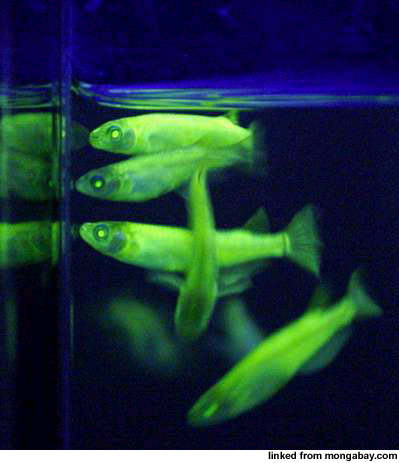Recent Biotechnology Innovation
Is a Bit Fishy: A Fluorescent Pet [picture]
By JASON DEAN
Staff Reporter of THE WALL STREET JOURNAL
TAIPEI, Taiwan -- In the basement of a building down an alley here floats the future of bioengineered pets, and it is glowing.
In a corner, small fish flit about in a dozen aquariums. Bill Kuo, a manager at Taikong Corp., draws a thick curtain and switches on black lights over the tanks. Suddenly, the fish glow a bright green. "Imagine you come home from work, turn out the lights and look at these," Mr. Kuo says. "It's very relaxing."
Fluorescent fish are just one of the latest off-the-wall innovations to come along in the biotechnology march. American researchers are seeking approval for a super-size salmon, retooled with growth hormones. A Canadian company, Nexia Biotechnologies Inc., is injecting spider genes into goats to produce milk that can be refined and woven into "BioSteel," for use in surgical sutures and "ballistic protection," the company says. Another Canadian group has trademarked the name "EnviroPig" for its genetically modified swine, whose manure contains fewer phosphates, a natural pollutant.
But Taikong's fish, which hit the market in Taiwan last month, may well be the world's first genetically modified house pets -- certainly the first designed to glow in the dark and one of the first leisure-time applications for genetic engineering. Born in a Taiwan biologist's lab in 2001 and written up in a scientific journal, the fish were soon discovered by Taikong, a 20-year-old company that sells aquarium equipment and fish food to shops around the world.
Willis Fang, Taikong's president, thought the appeal of the little green fish might go beyond research. He made plans to bring them to market as "Night Pearls," along with a whole line of products for the fish, such as black-lit tanks, fluorescent plastic coral and "fluorescent fish pellets" for food.
H.J. Tsai, a professor at National Taiwan University, with the glowing fish he created.
Word has traveled fast among aquarium enthusiasts. "If they can actually do this, it will be the greatest thing since popped corn," says Nevin Bailey, manager at Aquariumfish.net, a San Diego-based fish dealer who says customers have been asking him when they can buy glow-in-the-dark fish from Taiwan. "There's a lot of pent-up demand" for fluorescent fish in the U.S., he says, owing in part to articles about them in hobbyist magazines. Mr. Bailey, whose office is near a military base, sees a day when people will select their own color combinations. "My gosh, if they ever made one that was red, white, and blue, every Marine in the country would buy one."
The reaction in Europe, where resistance to genetic modification runs high, is different. "Fish shops in the U.K. won't touch them with a barge pole," predicts Derek Lambert, editor of Today's Fishkeeper, an enthusiasts' magazine. "There's a very strong anti-genetic-engineered-fish feeling in the U.K."
Indeed, early indications from Taiwan suggest Mr. Fang may have to tinker with his marketing plan. Fish shops stocking the glowing fish, modified rice fish a few centimeters long, say many people are looking at the transgenic swimmers, but only a few are laying down the $17.40 suggested retail price. "The color is striking," says Chen Yi-fung, a 30-year-old flight attendant staring at a tankful of finned glowsticks at New York, New York, a Taipei mall. "But this is a down economy. For a third the price, I might buy one."
The fish started out as research tools, not pet store novelties. H.J. Tsai, a professor of fisheries science at National Taiwan University, stumbled on the innovation while working with genetically modified fish for medical research.
Like many biologists in his field, Prof. Tsai was using a fluorescent protein extracted from jellyfish as a genetic marker, attaching it to DNA in embryonic fish to make specific genes easier to see under a microscope. Laboratories elsewhere have produced partially fluorescent pigs, mice and insects.
Prof. Tsai also creates fish with fluorescent hearts, which researchers at the University of California at San Francisco use to monitor development of the fish organ -- useful for understanding human heart development, since humans and fish share a significant portion of their DNA. But two years ago, Prof. Tsai hatched a surprise: fish that showed the fluorescent color brightly in every cell.
At first, the glowing fish were an interesting sideline for the professor, but he didn't plan to sell them. He saw them as miniature ambassadors for science. "Kids see these fish and they're fascinated," he says, smiling through heavy-framed glasses. Executives at Taikong who already knew Prof. Tsai saw in the fish a fluorescent gold mine.
They struck up a deal to sell the fish, breeding them at the company's "genetic fish stock bank" in a Taipei suburb. They sterilize the fish, so they won't contaminate wild populations if they are somehow set free. Prof. Tsai says he has been able to sterilize about 90% of the fish, which he says is safe enough.
The professor also created fluorescent red fish using a genetic protein from coral, and a half-red and half-green model. Taikong's Mr. Fang says he hopes the green fish will hit the U.S. by July, as soon as he secures commercial-use rights to the protein from its U.S. patent holder.
A U.S. distributor is already working out deals with big U.S. retail chains such as Petco Animal Supplies Inc. and Petsmart Inc., Mr. Fang says. A Petsmart spokeswoman says the company has heard of the fish but isn't planning to sell them at this time. Petco didn't respond to requests for comment.
Write to Jason Dean at [email protected]
Updated May 8, 2003
http://online.wsj.com/article/0,,SB105234499765401600,00.html?mod=todays%5Fus%5Fmarketplace%5Fhs
`'*:-.,_,.-:*'``'*:-.,_,.-:*'``'*:-.,_,.-:*'``'*:-.,_,.-:*'``
Frankenstein fish will glow in the bowl
By Thair Shaikh
(Filed: 05/05/2002)
A TAIWANESE company has created a genetically modified zebra fish that will glow in the dark, raising fears among environmentalists and the aquarium industry that the fish will start a trend for bio-engineered "Frankenstein pets". The modified fish are expected to be imported into Britain later in the year.
They are the first ornamental fish to be genetically modified. A jellyfish gene has been added to make them glow yellow-green. The GM Medaka or zebra fish - an east Asian freshwater variety - has been developed by Taiwan's Taikong Corporation. It is called the TK-1.
Taikong reported strong interest in Britain, where the aquatic industry is worth �300 million a year. It insisted that the TK-1 was safe, sterile and the fluorescent gene was not harmful. Taikong said it would satisfy European Union rules that genetically modified imports must not threaten health or the environment.
Aquatic industry specialists are worried, however, that the TK-1 is the first of many GM pet fish destined for Britain. Tropical fish are being bio-engineered to tolerate cold and could colonise British waters if they escaped.
"Piranhas that could survive in our waterways would be a major problem," said Derek Lambert, the editor of Today's Fishkeeper magazine, who is urging traders to boycott the TK-1. "We are worried about Frankenstein fish."
Keith Davenport, the Ornamental Trade Association chief executive, said: "Interfering with the genome is unnecessary. We don't want animals to become fashion accessories."
http://www.telegraph.co.uk/news/main.jhtml?xml=/news/2002/05/05/wfish05.xml
`'*:-.,_,.-:*'``'*:-.,_,.-:*'``'*:-.,_,.-:*'``'*:-.,_,.-:*'``
`'*:-.,_,.-:*'``'*:-.,_,.-:*'``'*:-.,_,.-:*'``'*:-.,_,.-:*'``
Frankenstein fish will glow in the bowl
By Thair Shaikh
(Filed: 05/05/2002)
A TAIWANESE company has created a genetically modified zebra fish that will glow in the dark, raising fears among environmentalists and the aquarium industry that the fish will start a trend for bio-engineered "Frankenstein pets". The modified fish are expected to be imported into Britain later in the year.
They are the first ornamental fish to be genetically modified. A jellyfish gene has been added to make them glow yellow-green. The GM Medaka or zebra fish - an east Asian freshwater variety - has been developed by Taiwan's Taikong Corporation. It is called the TK-1.
Taikong reported strong interest in Britain, where the aquatic industry is worth �300 million a year. It insisted that the TK-1 was safe, sterile and the fluorescent gene was not harmful. Taikong said it would satisfy European Union rules that genetically modified imports must not threaten health or the environment.
Aquatic industry specialists are worried, however, that the TK-1 is the first of many GM pet fish destined for Britain. Tropical fish are being bio-engineered to tolerate cold and could colonise British waters if they escaped.
"Piranhas that could survive in our waterways would be a major problem," said Derek Lambert, the editor of Today's Fishkeeper magazine, who is urging traders to boycott the TK-1. "We are worried about Frankenstein fish."
Keith Davenport, the Ornamental Trade Association chief executive, said: "Interfering with the genome is unnecessary. We don't want animals to become fashion accessories."
http://www.telegraph.co.uk/news/main.jhtml?xml=/news/2002/05/05/wfish05.xml
`'*:-.,_,.-:*'``'*:-.,_,.-:*'``'*:-.,_,.-:*'``'*:-.,_,.-:*'``
Taiwanese Scientists Create Ornamental Glow in the Dark GM Fish
A Taiwanese company has created a genetically modified (GM) ornamental fish that will glow in the dark, raising fears that a trend for bio-engineered "Frankenstein pets" has begun. The first modified fish are expected to be imported into Britain later in the year. The Taikong Corporation of Taiwan has inserted a gene from a jellyfish into zebra fish to make them glow yellow-green. Officially named the TK-1, they are the first ornamental fish to be genetically engineered.
Taikong reports strong interest in its GM fish in Britain, where the aquatic industry is worth millions. It insists that the TK-1 is safe, sterile and that the fluorescent gene is not harmful. Taikong said its fish would satisfy European Union rules that GM imports must not threaten health or the environment.
Aquatic industry specialists are worried, however, that the TK-1 is the first of many GM pet fish destined for Britain. Tropical fish are being bio-engineered to tolerate cold and could colonize British waters if they escaped. "Interfering with the genome is unnecessary," said Keith Davenport, Chief Executive of the Ornamental Aquatic Trade Association. "We don't want animals to become fashion accessories."
http://pewagbiotech.org/buzz/display.php3?StoryID=60glowing pets
`'*:-.,_,.-:*'``'*:-.,_,.-:*'``'*:-.,_,.-:*'``'*:-.,_,.-:*'``
CONTENT COPYRIGHT THE WALL STREET JOURNAL, THE TELEGRAPH. THIS CONTENT IS INTENDED SOLELY FOR EDUCATIONAL PURPOSES.
`'*:-.,_,.-:*'``'*:-.,_,.-:*'``'*:-.,_,.-:*'``'*:-.,_,.-:*'``
Back to mongabay.com






